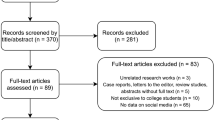Abstract
On the basis of acculturation theory, explicating mutual influences between different cultural or ethnic groups coming into contact, this study focused “on the other side of acculturation” theory by examining the effects of intercultural contact with Asians and Asian Americans on the psychosocial experiences of White American college students. Participants (N = 315), undergraduates attending a public university located within the state of Massachusetts, completed a survey that assessed demographic and personal characteristics, acculturation (extent of intercultural contact with Asian people and Asian cultures), attitudes towards Asians and Asian Americans, awareness of institutional discrimination and blatant racial issues, and psychological distress. Results indicated that White American students’ intercultural contact with Asians and Asian Americans contributed significant variance to the prediction of their attitudes towards this ethnic group and awareness of discrimination and racial issues, but not to psychological distress. This study provides implications for understanding mutual acculturative influences between different ethnic groups in the United States.
Similar content being viewed by others
References
Ancheta, A. (1998). Race, rights, and the Asian American experience. New Brunswick, NJ: Rutgers University Press.
Berry, J. W. (2003). Conceptual approaches to acculturation. In K. M. Chun, P. B. Organista, & G. Marin (Eds.), Acculturation: Advances in theory, measurement, and applied research (pp. 17–37). Washington, DC: American Psychological Association.
Berry, J. W. (2006). Mutual attitudes among immigrants and ethnocultural groups in Canada. International Journal of Intercultural Relations, 30(6), 719–734.
Berry, J. W., Poortinga, Y. H., Segall, M. H., & Dasen, P. R. (2002). Cross-cultural psychology: Research and applications (2nd ed.). Cambridge, England: Cambridge University Press.
Birman, D., Trickett, E. J., & Vinokurov, A. (2002). Acculturation and adaptation of Soviet Jewish refugee adolescents: Predictors of adjustment across life domains. American Journal of Community Psychology, 30(5), 585–607.
Carter, R. T. (1990). The relationship between racism and racial identity among White Americans: An exploratory investigation. Journal of Counseling & Development, 69, 46–50.
Chavous, T. M. (2005). An intergroup contact-theory framework for evaluating racial climate on predominantly White college campuses. American Journal of Community Psychology, 36(3–4), 239–257.
Cuellar, I., Harris, L., & Jasso, R. (1980). An acculturation scale for Mexican American normal and clinical populations. Hispanic Journal of Behavioral Sciences, 2, 199–217.
Derogatis, L. R. (1975). Brief Symptom Inventory. Baltimore, MD: Clinical Psychometric Research.
Hunter, L., & Elias, M. J. (1999). Interracial friendships, multicultural sensitivity, and social competence: How are they related? Journal of Applied Developmental Psychology, 20(4), 551–573.
Neville, H. A., Lilly, R. L., Duran, G., Lee, R. M., & Browne, L. (2000). Construction and initial validation of the Color-Blind Racial Attitudes Scale (CoBRAS). Journal of Counseling Psychology, 47, 59–70.
Ng, J. C., Lee, S. S., & Pak, Y. K. (2007). Contesting the model minority and perpetual foreigner stereotypes: A critical review of literature on Asian Americans in education. Review of Research in Education, 31(1), 95–130.
Ong, P., Agbayani-Siewert, P., Espiritu, Y., Hum, T., Inglis, C., Lee, T., et al. (2000). The state of Asian Pacific America: Transforming race relations. Los Angeles, Asian American Studies Center: Leadership Education for Asian Pacifics and University of California.
Pettigrew, T. F. (1998). Intergroup contact theory. Annual Review of Psychology, 49, 65–85.
Pettigrew, T. F., & Tropp, L. R. (2006). Interpersonal relations and group processes: A meta-analytic test of intergroup contact theory. Journal of Personality and Social Psychology, 90(5), 751–783.
Pope-Davis, D. B., & Ottavi, T. M. (1994). The relationship between racism and racial identity among White Americans: A replication and extension. Journal of Counseling & Development, 72, 293–297.
Population Division of the Department of Economic and Social Affairs of the United Nations Secretariat. (2006). World population prospects: The 2006 revision and world urbanization prospects. Retrieved July 11, 2007 from World Population Prospects: http://esa.un.org/unpp/p2k0data.asp.
Redfield, R., Linton, R., & Herskovits, M. J. (1936). Memorandum for the study of acculturation. American Anthropologist, 38, 149–152.
Reynolds, C. (2004). Far East moves West. American Demographics, October Issue. Retrieved July 11, 2007 from Find Articles: http://findarticles.com/p/articles/mi_m4021/is_8_26/ai_n6220886.
Rosenberg, M. (1965). Society and the adolescent self-image. Princeton, NJ: Princeton University Press.
Sarason, B. R., Sarason, I. G., Hacker, T. A., & Basham, R. B. (1985). Concomitants of social support: Social skills, physical attractiveness, and gender. Journal of Personality and Social Psychology, 49(2), 469–480.
Sears, D. O., Van Laar, C., Carrillo, M., & Kosterman, M. (1997). Is it really racism? The origins of White Americans’ opposition to race targeted policies. The Public Opinion Quarterly, 61(1), 16–53.
Suinn, R. M., Rikard-Figueroa, K., Lew, S., & Vigil, P. (1987). The Suinn-Lew Asian Self-Identity Acculturation Scale: An initial report. Educational and Psychological Measurement, 47, 401–407.
U.S. Census Bureau. (2000). Profile of selected social characteristics: 2000. Washington, DC: U.S. Department of Commerce, Economics and Statistics Administration.
U.S. Census Bureau. (2002). The Asian population: 2000. Washington, DC: U.S. Department of Commerce, Economics and Statistics Administration.
Utsey, S. O., McCarthy, E., Eubanks, R., & Adrian, G. (2002). White racism and suboptimal psychological functioning among White Americans: Implications for counseling and prejudice prevention. Journal of Multicultural Counseling and Development, 30(2), 81–95.
Wong, F., & Halgin, R. (2006). The ‘model minority’: Bane or blessing for Asian Americans? Journal of Multicultural Counseling and Development, 34(1), 38–49.
Yu, T. (2006). Challenging the politics of the ‘model minority’ stereotype: A case for educational equality. Equity & Excellence in Education, 39, 325–333.
Author information
Authors and Affiliations
Corresponding author
Rights and permissions
About this article
Cite this article
Dinh, K.T., Weinstein, T.L., Nemon, M. et al. The Effects of Contact with Asians and Asian Americans on White American College Students: Attitudes, Awareness of Racial Discrimination, and Psychological Adjustment. Am J Community Psychol 42, 298–308 (2008). https://doi.org/10.1007/s10464-008-9202-z
Published:
Issue Date:
DOI: https://doi.org/10.1007/s10464-008-9202-z




